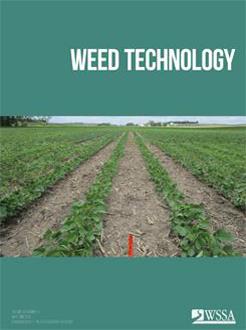Greenhouse and field studies were conducted to determine tolerance of blueberry to saflufenacil. Greenhouse studies included five saflufenacil rates (0, 50, 100, 200, and 400 g ai ha-1) and three southern highbush blueberry cultivars (‘Legacy’, ‘New Hanover’, and ‘O'Neal’) and one rabbiteye blueberry cultivar (‘Columbus’). Saflufenacil treatments were soil applied into each pot when blueberry plants were approximately 30-cm tall. Visible injury (purpling/reddening of foliage and leaf abscission) ranged from 3% to 12%, 3% to 42%, 0% to 43%, and 0% to 29% with saflufenacil from 50 to 400 g ha-1 in Columbus, Legacy, New Hanover, and O'Neal, respectively, at 28 d after treatment. Regardless of injury, plant growth (change in height), soil plant analysis development, and whole-plant dry biomass of all cultivars did not differ among saflufenacil rates. Field studies were conducted in Burgaw, NC, to determine the tolerance of nonbearing (<3-yr-old and not mature enough to produce fruit) and bearing (>3-yr-old and mature enough to produce fruit) southern highbush blueberry (‘Duke’) to saflufenacil application at pre-budbreak or during the vegetative growth stage. Treatments included three rates of saflufenacil (50, 100, and 200 g ha-1), glyphosate (870 g ae ha-1), glufosinate (1096 g ai ha-1), glyphosate (870 g ha-1) + saflufenacil (50 g ha-1), glufosinate (1096 g ha-1) + saflufenacil (50 g ha-1), and hexazinone (1,120 g ai ha-1), applied POST-directed to the soil surface beneath blueberry plants in a 76-cm band on both sides of the blueberry planting row. The maximum injury from treatments containing saflufenacil was ≤11% in both nonbearing and bearing blueberry. No negative effects on plant growth or fruit yield were observed from any treatments. Results from both greenhouse and field studies suggest that saflufenacil applied at 50 (1X commercial use rate) and 100 g ha-1 is safe to use in blueberry.
Nomenclature: Glufosinate; glyphosate; hexazinone; saflufenacil; highbush blueberry, Vaccinium corymbosum L.; rabbiteye blueberry, Vaccinium ashei Reade






